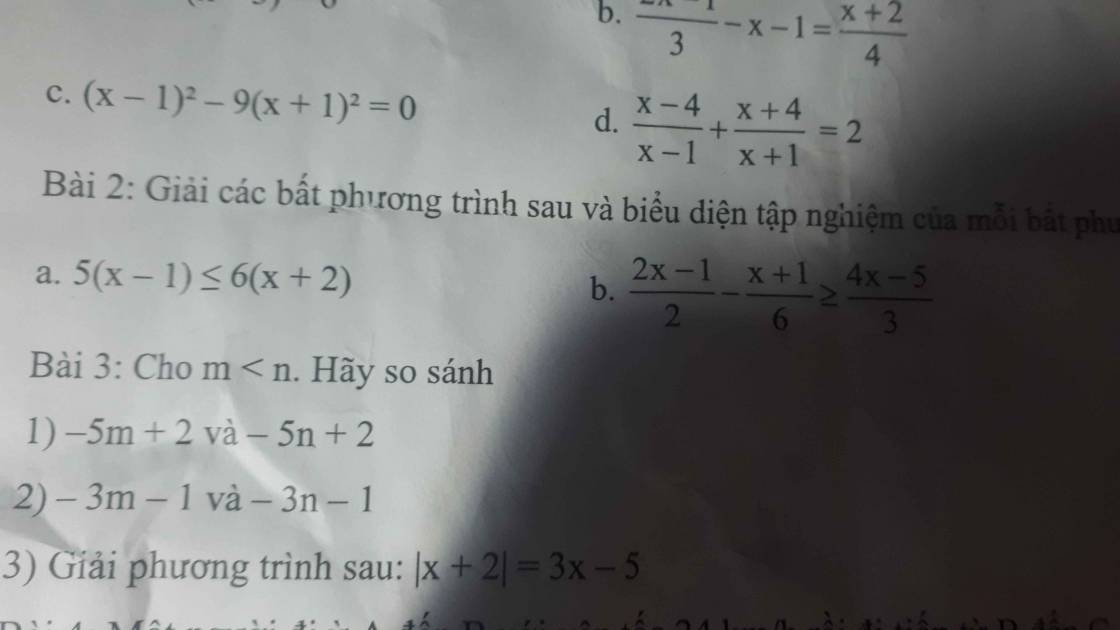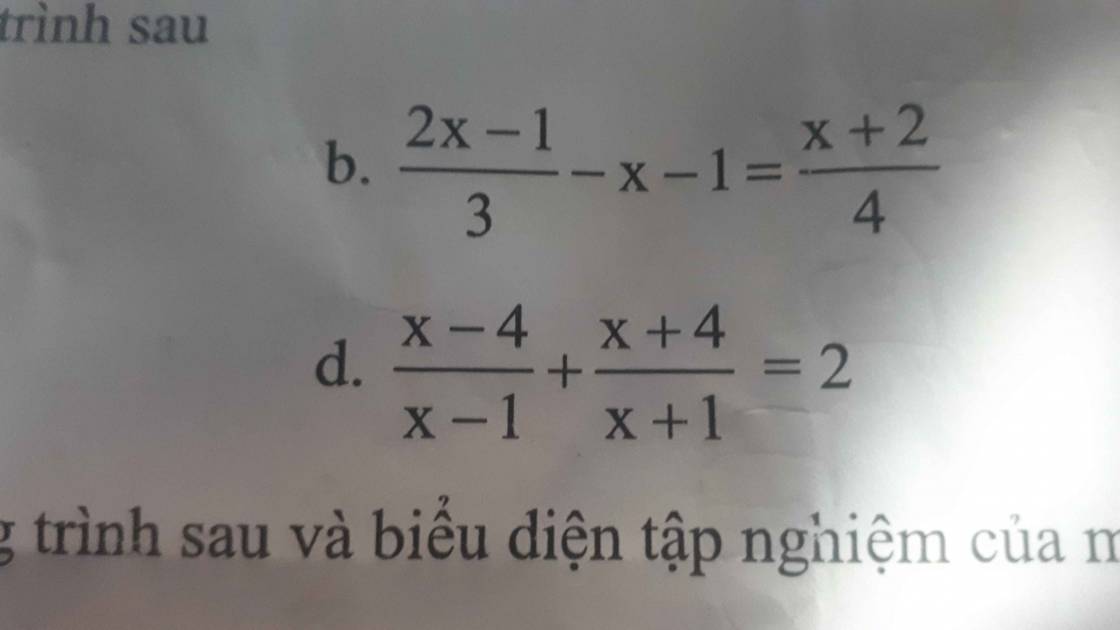 giúp mik bài 2 với
giúp mik bài 2 với
Hãy nhập câu hỏi của bạn vào đây, nếu là tài khoản VIP, bạn sẽ được ưu tiên trả lời.


\(\dfrac{x-4}{x-1}+\dfrac{x+4}{x+1}=2\)
ĐKXĐ: \(x\ne\pm1\)
\(\Leftrightarrow\dfrac{\left(x-4\right)\left(x+1\right)}{\left(x-1\right)\left(x+1\right)}+\dfrac{\left(x+4\right)\left(x-1\right)}{\left(x-1\right)\left(x+1\right)}=\dfrac{2\left(x-1\right)\left(x+1\right)}{\left(x-1\right)\left(x+1\right)}\)
\(\Rightarrow x^2-3x-4+x^2+3x-4=2\left(x^2-1\right)\)
\(\Leftrightarrow2x^2-8-2x^2+2=0\)
\(\Leftrightarrow-6=0\) (Vô lí)
Vậy phương trình trên vô nghiệm.

(4x2 + 8xy - 3xy2 )(-\(\dfrac{3}{4}\)x2y)
= -3x2y - 6x3y2 +\(\dfrac{9}{4}\)x3y3
4x3(2x2 - x + 5) 5x
= 20x4(2x2 - x + 5)
= 40x6 - 20x5 +100x4

\(\left(x-1\right)^2-9\left(x+1\right)^2=0\)
\(\Leftrightarrow x^2-2x+1-9\left(x^2+2x+1\right)=0\)
\(\Leftrightarrow x^2-2x+1-9x^2-2x-9=0\)
\(\Leftrightarrow-8x^2-4x-8=0\)
\(\Leftrightarrow-4\left(2x^2+x+2\right)=0\)
\(\Leftrightarrow2x^2+x+2=0\)
Xét \(\Delta=1^2-4\cdot2\cdot2=-15< 0\)
⇒ Phương trình vô nghiệm
Vậy \(S=\varnothing\).
(x-1)2 - 9 (x-1)2 = 0
(x-1)2.(1-9) =0
x-1 = 0
x = 1

Ta có: \(\left(x-1\right)^2-9\left(x+1\right)^2=0\)
\(\Leftrightarrow\left[\left(x-1\right)-3\left(x+1\right)\right]\left[x-1+3\left(x+1\right)\right]=0\)
\(\Leftrightarrow\left(-2x-4\right)\left(4x+2\right)=0\)
\(\Leftrightarrow\left[{}\begin{matrix}-2x-4=0\\4x+2=0\end{matrix}\right.\Leftrightarrow\left[{}\begin{matrix}x=-2\\x=-\dfrac{1}{2}\end{matrix}\right.\)
...

I'll let you draw the figure.
a) AM is a median of the triangle ABC. Therefore, M is the midpoint of BC.
E is symmetric to A through M, so M is the midpoint of AE.
Consider the quadrilateral ABEC, it has M is the midpoint of both AE and BC. Thus, ABEC is a parallelogram.
b) Consider the triangle ADE, M is the midpoint of AE, H is the midpoint of AD. Therefore, HM is the average line of this triangle. This means \(HM//DE\) or \(DE//BC\), which means BCED is a trapezoid.
Triangle ABD has the height BH, which is also a median. Thus, ABD must be an isosceles triangle, which means the height BH is also a bisector, or \(\widehat{ABH}=\widehat{DBH}\) or \(\widehat{ABC}=\widehat{DBC}\)
On the other hand, ABEC is a parallelogram. So, \(AB//CE\) and this leads to \(\widehat{ABC}=\widehat{ECB}\) (2 staggered angles of 2 parallel lines)
From these, we have \(\widehat{DBC}=\widehat{ECB}\left(=\widehat{ABC}\right)\)
The trapezoid BCED (DE//BC) has \(\widehat{DBC}=\widehat{ECB}\). Therefore, BCED must be an isosceles trapezoid.


5. (2 + x) (x+2) - \(\dfrac{1}{2}\) . (6-8x)2 + 17
= 5 ( x2 + 4x + 4) - \(\dfrac{1}{2}\). 4 ( 3 - 4x) 2+ 17
= 5x2 + 20 x + 20 - 2 ( 9 - 24x + 16x2) + 17
= 5x2 + 20x + 20 - 18 + 58x - 32x2 + 17
= -27x2 + 78 x + 19

Bài 2:
a) \(5\left(x-1\right)\le6\left(x+2\right)\)
\(\Leftrightarrow5x-5\le6x+12\)
\(\Rightarrow x\ge-17\)
b) \(\dfrac{2x-1}{2}-\dfrac{x+1}{6}\ge\dfrac{4x-5}{3}\)
\(\Leftrightarrow\dfrac{3\left(2x-1\right)-\left(x+1\right)}{6}\ge\dfrac{2\left(4x-5\right)}{6}\)
\(\Rightarrow6x-3-x-1\ge8x-10\)
\(\Leftrightarrow3x\le6\)
\(\Rightarrow x\le2\)
...